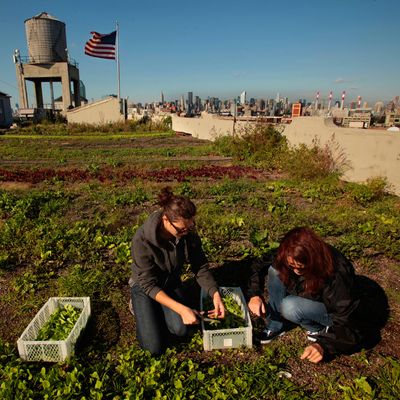
Everyone from Bill de Blasio to René Redzepi extols the virtues of urban farming, but what if it turns out that adding all this sweat and artisanal hand spades to compost isn’t actually helping alleviate world hunger? A new study by the Center for a Livable Future at Johns Hopkins suggests this is, alas, very likely the case, arguing that rooftop and schoolyard gardens are pretty terrible ways to feed people.
Here’s how program director Anne Palmer describes to Civil Eats people’s general misimpression:
“We often hear people saying, ‘We’re going to rebuild the city, create jobs, and feed people [through urban farms],’ and these things are, in my opinion, largely aspirational,” says Palmer. “It makes me uncomfortable that these groups are devoting a lot of energy and resources to something that might not be a panacea.”
The researchers reviewed 167 studies on urban agriculture and say they found community gardens typically “serve more as de facto neighborhood centers than hubs of commercial agricultural production.” They note neighborhoods often discuss the community-improvement benefits “with more enthusiasm than [they do] the production of fresh local food,” and go on to say that exaggerating the benefits beyond basic (albeit still important) education and civic engagement can trick officials into “disproportionally” allocating resources “at the expense of other, potentially more effective interventions.” They point to one eye-opening study that found transforming all of New York’s vacant land into urban farms would yield enough produce to feed only 100,000 to 160,000 people, just a sliver of the city’s 8.4 million residents.
The straight shooting doesn’t stop there, either. The report goes on to rain all over the parade of people who think urban gardens are incredibly ecofriendly:
Urban agriculture may not always provide environmental benefits, and could in some cases lead to net negative ecological impacts. For example, indiscriminate fertilizer or compost application may pollute surface water or storm-water runoff with excessive nitrogen, phosphorus, and/or potassium.
…
Moreover, producing food in urban settings may increase GHG emissions and water use if plants are grown in energy- and resource-intensive operations, such as indoor/vertical farming, greenhouses, hydroponics (soilless crop production), or aquaculture (the cultivation of aquatic animals or plants for food) facilities in cold or water-scarce regions.
Or those who think the produce grown in them is a ton healthier:
Urban food growers may be exposed to soil contaminants (e.g., via accidental ingestion during gardening activities), while persons who consume food grown in contaminated soil may ingest pollutants on the surface of produce and, in some cases, in the tissues of the plant (particularly root vegetables). Exposure to these contaminants can lead to a number of negative health impacts including nervous system damage and certain cancers.
But obviously, the report’s co-author adds, that doesn’t mean urban farms are worthless: “I wouldn’t rule out urban agriculture as something we shouldn’t be doing because it can’t be a panacea for all of our problems.” She says the takeaway is more that “we have to be really careful about how we communicate the potential of urban agriculture.”




